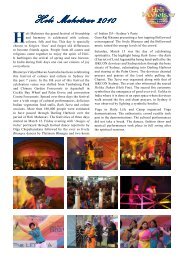'The whole world is but one family' - Bharatiya Vidya Bhavan Australia
'The whole world is but one family' - Bharatiya Vidya Bhavan Australia
'The whole world is but one family' - Bharatiya Vidya Bhavan Australia
Create successful ePaper yourself
Turn your PDF publications into a flip-book with our unique Google optimized e-Paper software.
Evolution of Cave Temples<br />
The presence of so many cave temples<br />
dedicated to Buddh<strong>is</strong>m, Jain<strong>is</strong>m and Hindu<strong>is</strong>m<br />
in Western Maharashtra point to the fact that<br />
true religion <strong>is</strong> faith and living in the presence of God.<br />
These caves also tell us that all religions are equal in<br />
the sense that they try to meet the felt need of humans<br />
for spiritual progress.<br />
The question that comes up in <strong>one</strong>’s mind <strong>is</strong> why<br />
there <strong>is</strong> concentration of so many cave temples in <strong>one</strong><br />
area and how long has the evolution been going on.<br />
As all the three main prevailing religions of India<br />
co-ex<strong>is</strong>ted, some of the striking similarities in terms<br />
of architecture as well as icons seem to suggest that<br />
all of them were tolerated, accepted or welcomed<br />
by all. What <strong>is</strong> it that has caused th<strong>is</strong> religious<br />
tolerance and how did the architectural and iconic<br />
similarity permeate each other’s field? Before going<br />
into the details, it <strong>is</strong> necessary to walk through the<br />
evolutionary path that man took to reach the stage of<br />
carving a permanent shelter in ex<strong>is</strong>ting rocks or hills.<br />
Starting with the evolution of human beings, evolution<br />
of human dwelling also was taking place. As the<br />
human being evolved into a different social animal,<br />
he chose to protect himself and h<strong>is</strong> family from the<br />
wild animals, the harsh climates and the blazing sun.<br />
Th<strong>is</strong> he did by erecting a roof over him. Over a period,<br />
th<strong>is</strong> plain roof became a mud, mortar and wooden<br />
architecture. The improvement in the architectural<br />
design of mud and wooden/thatched homes also<br />
influenced the temple architecture, though made of<br />
the same material.<br />
In the beginning, it was functional, just to provide<br />
a home. Later, the sunlight and ventilation were<br />
controlled and windows were added. Then a place of<br />
worship was added, at a higher level, as God should<br />
be at a higher level than the human being. Therefore,<br />
temples became more ornate and were placed on an<br />
elevation. Another reason for elevating the abode of<br />
God was, the notion that God lives in heaven, which<br />
<strong>is</strong> supposed to be high above. Th<strong>is</strong> was the religious<br />
zeal along with man’s need for aesthetic beauty in the<br />
house as well as outside h<strong>is</strong> house, i.e., h<strong>is</strong> relation<br />
with God.<br />
What better place can there be than a hill or mountain<br />
to give that desired elevation for God’s abode to<br />
signify h<strong>is</strong> superior ex<strong>is</strong>tence? Also to indicate that<br />
<strong>one</strong> has to make an effort to get to God, all these cave<br />
temples were situated away from the town or city,<br />
neither too close nor too far.<br />
Perhaps another reason was to maintain a d<strong>is</strong>tance<br />
-Rajeswari Raghu<br />
from the laymen. Or was it a test for the monks and<br />
the sanyas<strong>is</strong> who lived closer to the Hindu caves?<br />
Interestingly, some of the Hindu caves have Mithuna<br />
couples in the main temples, a self test whether the<br />
grahasthashrama period <strong>is</strong> over, or some <strong>world</strong>ly<br />
desires were still left. As the sculptors became more<br />
adept in ornated figures and structures, a permanent<br />
and secure place was needed to express the devotion<br />
or bhakti on a permanent bas<strong>is</strong>. Granites, marbles and<br />
other soft st<strong>one</strong>s were already in experimental use<br />
along with different wood.<br />
Another happy situation was that India was going<br />
through a prosperous period. There was political<br />
stability, religious freedom, tolerance towards other<br />
religions and above all, there was royal patronage. A<br />
new type of art<strong>is</strong>ts and the guild system came up which<br />
wanted them to try their hands at different things.<br />
The followers of all the three religions, i.e., Hindu<strong>is</strong>m,<br />
Buddh<strong>is</strong>m and Jain<strong>is</strong>m were rich in religious scriptures,<br />
and were also competing with each other in selecting<br />
and establ<strong>is</strong>hing or building places of worship. The<br />
prosperity also encouraged trade with far off places.<br />
These trades resulted in “trade routes”, which also<br />
connected the Buddh<strong>is</strong>t cultural centres. There <strong>is</strong> a<br />
suggestion that the land trade routes covered Lumbini<br />
(present Nepal), Samarkand (present Afgan<strong>is</strong>than) and<br />
Dvarkavrata (present Dwarka). The Buddh<strong>is</strong>t monks<br />
travelled to other centres so did the traders. Both<br />
needed each other. There were sea routes also through<br />
which business was carried out with Sri Lanka, and<br />
Arab countries.<br />
Why Cave Temples?<br />
As India was becoming prosperous through trade,<br />
more people had to travel from place to place. These<br />
trade travels took a long time to complete and on the









